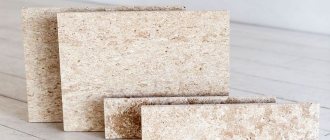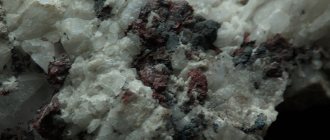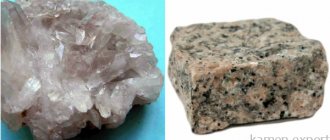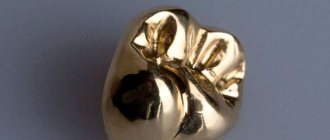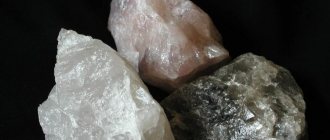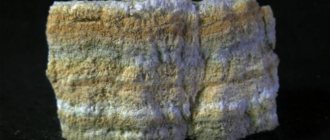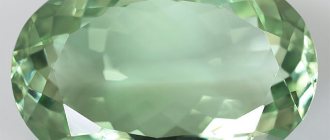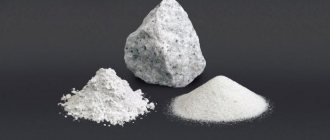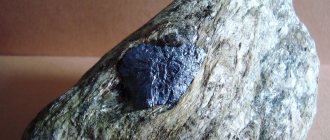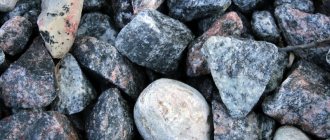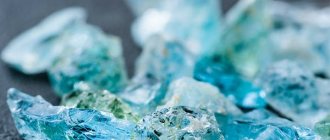What is tuff?
Tuff is a type of sedimentary rock that has a porous, heterogeneous structure. The mineralogical composition and properties of stones depend on the method of tuff formation. The following types are distinguished:
- Limestone or travertine. It is formed under the influence of geothermal waters on natural materials located in their path. The main component is carbonated lime. During the formation of limestone, it combines with iron, aluminum, and silicon oxide. A porous and light stone is formed. The material travertine has low hardness and is not resistant to moisture.
- Siliceous, or geyserite. Appears when geyser vapors, which contain silicon compounds, fall and cool. The structure is similar to travertine, but does not collapse under the influence of moisture. The stone is hard and durable and may scratch the glass surface.
- Volcanic. The most popular type of tuff. It is formed as a result of the fall, sedimentation and cementation of volcanic ash, pieces erupting from a volcanic vent during an eruption, and various impurities. The photo shows examples of this type.
Tuff ensured immortality for Armenian temples
If this term had not been adopted by alchemists, tuff would have been called the philosopher's stone in Armenia. At least, the immortality of temples built from this material has already been ensured.
Volcanic tuff is formed, as its name suggests, from fossilized ejecta from volcanoes. In Armenia, tuff is a “wide-profile” stone: sheds, houses, and churches are built from it. It was the temples that brought this bright and light stone its first glory.
About 90% of the world's tuff reserves are concentrated in Armenia. In addition to Armenia, there are also tuff deposits in Italy (near Rome and Naples), Iran, etc.
Armenian tuff was also used far beyond the borders of the USSR. The United Nations Headquarters complex (UN headquarters) in New York was built in 1951 on the eastern side of Manhattan.
Architects, designers and engineers from all over the world were invited to create this complex. This group of designers included Nikolai Basov (USSR), Max Abramovich (USA), Oscar Niemeyer (Brazil), Vladimir Bodyansky (France), Ernst Cormier (Canada), Wallace K. Harrison (USA), Charles and Le Corbusier (France) , Sven Markelius (Sweden), G.A. Svajö (Australia), Liang Sicheng (China), as well as consultants Anthony Antoniades (Greece), Matthew Nowicki (Poland) and Ernest Weissman (Yugoslavia).
Tuff is a rock of volcanic, geothermal and sedimentary origin, formed during the outpouring of magmatic material onto the surface or during the deposition of carbonate and siliceous solutions in places where geothermal springs emerge.
Accordingly, carbonate (calcareous), siliceous (felsite) and volcanic tuffs are distinguished. Calcareous tuffs are intermediate forms between limestone and marble.
Armenian tuff is a group of stone rocks formed from volcanic ash. Tuffs are divided into calcareous (travertine), volcanic and felsic (felsite). It has lain in the ground for billions of years and will stand in any conditions.
Being a product of a volcanic eruption, they can have a very different composition. The density also varies, which affects the possibility of using this material for certain purposes. Even close to the same point, volcanic tuffs can have different compositions, depending on differences in eruptions and the type of source rocks.
However, all types of this material always have something in common: porosity. This is due to the fact that volcanic rock is sintered small fragments and the remains of ash and sand.
As a result, it has amazing water and frost resistance, as well as lightness. As a rule, tuff is also relatively soft, although this depends on the specific samples. E
This property made it possible to process this type of rock without the use of complex tools - just with a saw and an ax. At the same time, volcanic tuffs are not inferior in strength to, for example, granite. Well, in terms of the totality of properties, they are even superior in some ways.
The stone has long been a symbol of eternity. Stone houses personified strength, reliability, wealth and beauty.
It is easy to process, lightweight, porous, and has more than forty shades from black to white. In addition, hard types of tuff are also quite earthquake resistant. But the most practical is pink.
In Armenia it is used most often in construction. The reserves of tuff are practically inexhaustible. Its physical and mechanical properties, strength and frost resistance are evidenced by the monuments of ancient Armenian architecture built from tuff that have reached us: the remains of Armenian cyclopean structures dating back thousands of years, churches located high in the mountains, exposed to huge temperature changes, are clear evidence of this.
Tuff is the calling card of Armenian cities
Composition and structure of volcanic tuff
The volcanic variety has a porous, heterogeneous structure. In one rock fragment there may be inclusions of large or small solid natural materials that differ in color from the base. Tuff contains more than 50% silicon oxide. It also contains oxides of aluminum, manganese and iron. Physico-chemical characteristics of the rock:
- porosity – 21.3 – 46.6%;
- low thermal conductivity;
- Mohs hardness – 3 points;
- compressive strength – up to 60 MPa;
- specific gravity – from 1.4 to 2.5 g/cc;
- high degree of sound insulation.
This type of breed is characterized by resistance to moisture, exposure to sun and wind. The stone is able to withstand sudden temperature changes. It is easy to cut into pieces and give it the desired shape.
In nature, there are different colors of rocks. Depending on the presence of impurities and the percentage of elements of the main composition, there are purple, gray, yellow-brown, pink, red, gray, orange and black specimens.
Pink tuff
Pink tuff used on facades
If you find yourself in the capital of Armenia, Yerevan, you will see Mount Ararat towering in the distance, casting a shadow over the city, shrouded in pink. It was from this perspective that Yerevan became known as the Pink City of Armenia: its Soviet-era buildings were constructed from pink stones quarried from the surrounding landscape. Color is best captured at sunrise and sunset and changes throughout the day depending on where the sun is at that moment.
The unique building stone of Yerevan is actually the same volcanic rock - tuff, which does not have a typical black or gray tint, but from light pastel colors to bright pink with a splash of orange. From a scientific point of view, this stone still consists of compacted volcanic ash, sand and lava, ejected during an eruption. Although a similar type of stone can be found in Turkey and parts of the southwestern United States, pink tuff is rarely found outside the region, and Yerevan is the only major city built from it. Jack Lockwood, a volcanology consultant, says the difference in color is due to both the speed of lava flow and the oxidation that occurs.
History and origin of the mineral
Formed in areas where volcanoes are common. When they erupt, small particles of dust, lava, and minerals spread through the air and then settle. As they accumulate, they form tuff layers. They are characterized by a wide distribution over an area, with a thickness of 10–15 meters.
The breed has always been a convenient building material.
Famous architectural monuments, monasteries, and churches were built from it. Houses and public buildings were built in Armenia, Georgia, and Italy.
See historical information about the birthplace of the mineral:
Yerevan: the charm of a city made of pink tuff
Panorama of the city with a view of the Cathedral of St. Gregory the Illuminator from The Alexander Hotel Photo: Sergey Tsekhmistrenko It so happened that over half a century I visited almost all the capitals of the republics of the former USSR, but I never managed to visit Yerevan. Over time, the desire to be here only grew, regularly reinforced by stories from friends and acquaintances about the beauties of the Armenian capital, located in a picturesque valley surrounded by the peaks of the Caucasus. And when the cathedral of the Armenian Apostolic Church, faced with pink tuff brought from Armenia, appeared in the center of Moscow, I realized that I could not postpone it any longer. After all, Yerevan is famous for the fact that before the 1917 revolution, almost all buildings were decorated with this volcanic material, which became the dominant feature in the aesthetic perception of this city.
Geghard monastery complex Photo: Sergey Tsekhmistrenko
However, the opportunity to get to Armenia presented itself only last winter. Of course, there were fears that at this time of year the impressions of Yerevan would not be the most vivid. Reality dispelled all fears: on the contrary, the bright colors of spring or summer no longer overshadowed the beauty of ancient buildings. “The city of eternal vacations,” as many travelers call Yerevan, appeared before me in all its rosy splendor. And not only in pink: many houses in the 18th–19th centuries were decorated with rarer, black tuff. The only pity is that in Soviet times, architects refused to continue the tradition: many buildings of the 20th century are painfully similar to their “brothers” in all corners of the former Union. And only the historical center of the city is truly unique.
When reconstructing old buildings, modern architects try to preserve as much as possible their appearance, familiar to generations of Yerevan residents and guests of the city. This, for example, happened with The Alexander Hotel, the first hotel in Armenia of The Luxury Collection chain, part of the Marriott International group. The building of this hotel turned out to be literally inscribed in the 18th century facade made of black tuff. It must be said that The Alexander became the first hotel in the luxury segment, not only in Yerevan, but throughout Armenia. Its opening last year sharply increased the attractiveness of Armenia, which so far cannot boast of achievements in the tourism industry, significantly inferior to neighboring Georgia and Azerbaijan. Well, after Angela Merkel and Emmanuel Macron became hotel guests, who chose the 150-meter suite as their residence during their official visits to Armenia, it was impossible to imagine better advertising. Politicians, big businessmen, and simply wealthy foreigners began to stop here, who for one reason or another decided to visit the city at the foot of Mount Ararat. By the way, the legendary mountain is clearly visible from the hotel's open gallery surrounding its restaurant on the top floor. The restaurant itself is Italian, but its team of internationally recognized chefs is ready to offer guests local dishes adapted to Mediterranean cuisine, for example, smoked trout, popular in this region.
Landscape of Armenia Photo: Sergey Tsekhmistrenko
Having settled in The Alexander, it is very convenient to explore almost all the sights of Yerevan - they are all within walking distance. For example, Republic Square, an architectural masterpiece of the Soviet era with its famous “Singing Fountains”. It was on this square that events that culminated in a change of power in Armenia most recently took place. Or the Matenadaran Institute of Ancient Manuscripts, which houses ancient Armenian manuscripts and other ancient documents of the early Middle Ages. One side of the hotel faces Pushkin Street, with its numerous cafes and bars, among them the jazz club “At Malkhas”, famous far beyond the borders of the republic. It is convenient to make raids on ancient monuments nearby Yerevan from the hotel. For example, to the rock monastery complex of Geghard, listed by UNESCO as a World Cultural Heritage Site. Its name translated from Armenian means “monastery of the spear”: it was here that the spear of Longinus, with which the Savior was pierced on the cross, was kept - now it is in the museum of the Etchmiadzin Monastery, the residence of the Catholicos of all Armenians. Or see the only pagan temple in Armenia of the 1st century AD located nearby. e. in Garni, dedicated to the sun god Mithra. And just 60 kilometers from the hotel is the country’s most famous ski resort, Tsakhkadzor, which in recent years has become popular among tourists from Russia.
Fake diamond
Artificial diabase facade
Artificial diabase is a decorative material used for cladding facades. Its main characteristics - strength and durability - are in no way inferior to the similar properties of natural stone.
Thanks to its composition, artificial diabase is much lighter than its natural counterpart, but it is more resistant when in contact with modern reagents, practically does not absorb water and is perfectly sanitary.
The process of producing artificial diabase is referred to as “vibration casting”, since the material used is compacted using vibration.
In order for the texture of the artificial stone to closely resemble the pattern of natural diabase, it is cast using special silicone molds.
Using special colors obtained on specialized equipment, artificial stone is painted in tones characteristic of natural minerals.
A building lined with artificial diabase will not only acquire an attractive appearance and additional thermal insulation, but will also be reliably protected from mechanical damage and dampness for several decades.
Positive and negative qualities of the material
The physical and mechanical properties of the building material tuff indicate that it has only one negative quality - high moisture absorption. It is associated with the high porosity of the tuffs. However, if you look from the other side, it makes the stones light and warm. This is a big plus. And tuff structures can be protected from moisture and frost with insulation and exterior finishing. The main properties of tuff stone vary depending on the deposit and are within the following boundaries:
Nature surprises with the colors of tuff. Different places of origin produce tuff rocks of black, brown, red, brown, lilac, orange, green, yellow, purple and other colors and shades.
The best qualities of tuff:
- sufficient strength and long service life;
- excellent sound and heat insulation;
- light weight;
- high resistance to heat and frost.
The stones are easily machined and can be stored in any conditions. With high porosity, the material is not subject to weathering and destruction due to exposure to atmospheric phenomena. It has a rare property - by nature, a loose stone when exposed to air hardens and becomes more durable.
Armenian volcanic tuff
Tuff is an igneous rock. This is a product of volcanic emissions, carried by gas flows from the depths of loose igneous material - volcanic ash, which accumulates on its surface, sintering and compacting, gradually forming powerful deposits. The porosity of tuff significantly increases its sound insulation properties and increases water resistance and thermal insulation. Tuff is more durable than brick, and is also better in water resistance.
The tuffs occurring on the territory of Armenia are largely classified as quaternary sintered, in contrast to cemented ones, in which volcanic ash is held together by natural cements of various compositions. This means that their appearance dates back to the Quaternary period of the Cenozoic era (250 million years ago).
The classification of Armenian tuffs depending on their composition, petrographic characteristics, physico-chemical, mechanical and other properties is as follows:
- Ani tuff - light shades, the lightest
- Artik tuff (pink tuff) - with shades of pink-lilac-violet
- Yerevan tuff (Oktemberyan-Gyumri) - with shades of black-brown-red
- Byurakan tuff - with many inclusions of stones, minerals and stains of various shades
- Felsite tuff
According to the age of formation, the first four types of tuffs belong to the Quaternary period, the last - to the more ancient, Tertiary.
Tuff is used as a building (blocks) and facing (slabs) material. Thanks to its unique porous texture, rich range of colors (there are up to 30 tuff color shades in nature), frost resistance, excellent sound and thermal insulation, a tuff structure is almost eternal. Examples include churches and tuff buildings still in use today, built in the early 15th century around Lake Sevan. For centuries they have been in conditions of constant humidity and are subject to temperature changes from -40 to + 40 degrees.
Tuff cladding adds monumentality and a special style to any structure. Tuff goes well with other finishing materials - wood, glass, metal, polished stones, and therefore tuff processing provides an excellent opportunity to realize the ideas of architects.
Numerous architectural monuments of antiquity, built from Quaternary volcanic tuffs, stood for 1,500 years or more. The history of Armenian architecture is connected with it. Yerevan, which is over 2800 years old, is entirely built of tuff, basalt, marble and other natural stones. There is not a single city in Armenia that does not use tuff as a wall material. The Cathedral in Etchmiadzin was built in 301-303. made of tuff and still amazes with its grandeur. The steps on which the spectators were seated in the huge theater in Pompeii were built in the 2nd century BC. from tuff. In modern Russia, the buildings of the Ust-Ilimsk hydroelectric power station (high humidity conditions), neighborhoods in Novy Urengoy (harsh climatic conditions) and Slavutich and many other examples of the use of tuff allow us to speak about the high performance qualities of this stone.
In St. Petersburg, on Domostroitelnaya Street (Parnas), there is a magnificent example of the use of tuff on the facade of a building. Successfully withstood the tests of St. Petersburg weather.
In the form of blocks, tuff is much stronger than brick, and its water resistance is several times greater than brick. Thanks to its porosity and other properties, tuff provides an optimal indoor climate at any time of the year. In a cold room, tuff retains heat, and in hot weather it keeps cool. Tuff tiles are often used to create recreation rooms. Such rooms maintain a comfortable microclimate and isolate the vacationer from extraneous sounds due to their porous structure. And tuff is ideal for wine cellars and external fireplace linings.
Overview of species
Almost 90% of volcanic tuffs consist of products - emissions from explosive eruptions. Frequently there is movement of clastic material by mud flows and saturation of the rock with secondary minerals. If other impurities predominate, then the tuffs are divided according to their mineral composition into:
- andesitic;
- liparitic;
- basalt;
- trachytic.
Tuffs can be sintered or cemented; their strength characteristics depend on the method of formation. Sintered rocks are stronger than those cemented with natural cements.
Based on density they are divided into:
- the tracks are tightly compressed;
- pozzolans are loose.
Natural stones: pros and cons
Minerals taken from the natural environment have many benefits:
- cheap or even free material for decorations;
- variety of shapes and colors;
- look natural;
- easy to wash and clean;
- can be used to bring any composition into reality.
They have only one drawback: some rocks can change the hardness and acidity of the aquatic environment, sometimes to a critical level. This feature must be taken into account when arranging a home pond.
Sometimes natural stones are coated with dyes and glued together. If the work is done poorly, the composition will collapse and cause deterioration in the health of the fish. Below is a list of breeds commonly used by aquarists:
- Pebbles. Pebbles for an aquarium are a universal decor. Rocks that fall into bodies of water and are exposed to water for a long time acquire rounded shapes. They come in various sizes and colors, with veins and inclusions.
- Sandstone. Sedimentary rock that consists of sand and clay. Sandstone for an aquarium is not always a good decorative option, as it changes the hardness and acidity of the aquatic environment. In addition, some species are very fragile.
- Limestone. The basis of this mineral of sedimentary origin is calcium carbonate. Possible inclusions of magnesium salts and fossils. Has a solid or loose structure. Limestone increases the hardness and acidity of the aquatic environment and quickly becomes overgrown with algae.
- Granite. It is of volcanic origin. Does not release hazardous substances into water. A heavy multi-colored mineral with a mosaic of different colors. Often used by aquarists to build rock compositions. An aquarium with granite stones looks impressive.
- Gneiss. Slate is a type of solid rock that does not affect the water structure and composition. Pebbles with colored stripes can be safely used to create decor.
- Shell rock. The porous formation of compressed mollusk shells is easy to process to create an aquatic landscape. Shell rock is one of the most common rocks for decoration.
- Tuff. This porous rock is based on volcanic ash. Lightweight, durable, comes in a variety of colors. One of the rock varieties is calcareous tuff. A suitable material for arranging a home for fish that love an alkaline environment and many pitfalls.
- Quartzite. Small grains of quartz fused into one pebble. High strength, but at the same time it can be easily divided into parts. Quartz is found in pink and green shades.
- Gabbro-diabase. Stone of volcanic origin is one of the most durable and widespread in nature. Crushed stone is made from it and pavements are laid. The structure is compared to basalt. Does not emit harmful substances, suitable for creating underwater compositions.
- Jasper. A semi-precious solid opaque mineral that is not just a decoration, but also has special energy. The main component of jasper is quartz. It looks especially beautiful in red.
Tuff price
The price of tuff depends on the color of the original rock and the degree of processing of the final blocks. Tuffs can be processed by sawing, grinding, polishing, and artificial aging. The cheapest cost per square meter of sawn tuff will be the most expensive, respectively, polished and artificially aged tuff.
You can buy tuff in bulk, then the price per batch will be significantly reduced. Natural tuff stone is distinguished by a surprisingly wide color palette and a unique texture, with a transition from one color to another: when cut, the stone can resemble the structure of natural wood.
Thanks to its properties, tuffs are becoming an increasingly popular finishing material, whose decorative properties are highly valued by architects and decorators, and whose functional properties are highly valued by builders.
Description and classification of the main types of pyroclastic rocks
There is currently no general classification of pyroclastic rocks. This review takes into account the data of the first volcanological conference in 1959.
Pyroclastic rocks are divided according to the quantitative ratio of volcanic and sedimentary material. Further division is carried out according to the size of the constituent parts, petrographic composition and structure of the fragments, homogeneity and heterogeneity of the rock-forming material, etc. Based on the content of volcanogenic material, pyroclastic rocks are divided into three groups.
1. Volcanic tuffs and tuff breccias (synonym - volcanic breccias) - rocks composed almost exclusively of volcanogenic material (more than 90%).
2. Tuffites - rocks composed of volcanic and sedimentary material. The content of the latter is less than 50%.
3. Tuffaceous rocks (synonym: tuffaceous-sedimentary rocks) - rocks with a predominance of sedimentary material (more than 50%). Some authors classify them as sedimentary rocks.
Tuffs and tuff breccias (volcanic breccias). Tuffs and tuff breccias are pyroclastic rocks in which both fragments and cementing material are the product of volcanic emissions formed during explosive volcanic activity. During secondary changes, which easily occur here due to the porosity of the rock, cementation of the binding material of the tuffs occurs. The processes of carbonatization, silicification, pelitization, chloritization, epidotization and other secondary changes are widely developed. Based on the predominant size of their constituent parts, these rocks are divided into the following groups: 1) tuff breccias (volcanic breccias) - >30 mm; 2) coarse clastic tuffs - 30-5 mm (corresponding to the size of a walnut to a pea); 3) coarse tuffs - 5-1 mm; 4) fine-clastic tuffs - 1-0.1 mm. The debris is visible to the eye. 5) fine clastic tuffs - 0.1 mm. Based on the structure of the predominant fragments, crystalloclastic tuffs and tuff breccias are distinguished. In rocks of this type, there is a sharp predominance (>75%) of minerals that are lava franks ejected during gas explosions. Lithoclastic tuffs and tuff breccias. In rocks of this type, the fragments are represented predominantly (>75%) by rocks, usually effusive, to which fragments of other rocks or minerals may be mixed. A variety of lithoclastic tuffs are vitroclastic (Fig. 1-III), in which the fragments are represented by volcanic glass (Fig. 2-III), as well as ash tuffs (traces, pozzolans). The latter are the most fine-clastic varieties of tuffs and consist of fragments of glass, usually rich in silicic acid; the fragments may be angular or in the shape of hairs, arches, or drops. Among the ash tuffs, pisolite tuffs are distinguished, which are characterized by the presence of small spherical particles, which are probably drops of volcanic glass that were ejected from the lava during explosions. In volcanic breccias and coarse clastic tuffs, lithoclastic material usually predominates; in fine- and fine-clastic tuffs, in vitro- and crystalloclastic material predominates. Based on the petrographic composition of the fragments of extrusive rocks and minerals present in the tuff, as well as the mass that binds them, basalt, trachyte, liparitic and other tuffs are distinguished. For example, basaltic tuff contains fragments of basaltic rocks, fragments of crystals of basic plagioclase, olivine, and pyroxene. Ash tuffs often correspond in composition to liparites and are characterized by a high content of silicic acid. Ignimbrites are unique and widespread pyroclastic rocks in nature, corresponding in composition to quartz porphyries - liparites. Ignimbrites were formed during colossal eruptions of acidic lava that occur from under domes of extruded lava. Under enormous pressure, a mass of hot material, very rich in gases, forms a kind of “suspension”, which sinks to the surface of the earth and is capable of flowing like a liquid stream. In the lower parts of such flows, ■partial melting and sintering of ash particles may occur. The structure of ignimbrites is often intermediate between the structure of tuffs, tuff lavas and ordinary lavas.
Diamond-bearing picrite tuffs, widely developed in Africa and northeastern Siberia, are known as kimberlites. Tuffs and tuffites are extremely diverse rocks in color and appearance. Among the tuffs there are dark, bluish-gray, pink-violet (Artik tuffs of Armenia), brown-gray, green, light violet, greenish (Karadag routes), etc. As a rule, darker tuffs correspond to tuffs of basic ultramafic composition, lighter ones - tuffs of acidic composition. A characteristic feature of most tuffs is their strong secondary changes. The tuffs of the acid series are least altered. Some authors propose to further classify tuffs according to facies conditions into vent facies, near-vent facies, and facies formed at a significant distance from the place of ejection of pyroclastic material (Bykovskaya, Gapaeva, Boretskaya et al., 1959). Tuffites. Tuffites are pyroclastic rocks containing less than 50% sedimentary material (clastic, chemogenic, organogenic). Tuffites and tuffogens are usually formed in an aquatic environment, as evidenced by the admixture of corresponding sedimentary rocks and even marine fauna in them (for example, in shalypteyns). However, tuffites of terrestrial and mixed origin are known. The latter are formed, for example, in cases where mud flows accompanying a volcanic eruption descend from the cone into a water basin and are partly in the aquatic environment, partly in the terrestrial environment (Maleev, 1959a). Tuffites occupy an intermediate position between tuffs and tuffaceous-sedimentary rocks. Tuffites often contain significant amounts of clayey, carbonate and other material, organic remains, and detrital grains. In some tuffites rich in sedimentary material, layering is clearly visible. When enriched with pyroclastic material, tuffites acquire the characteristic features of tuffs. Based on the size of the constituent rocks, tuffites are divided similarly to tuffs. If the pyroclastic material in tuffites is more or less homogeneous in composition, then the tuffites can be called “spilite tuff”, “andesitic tuff”, etc. Tuffogens (tuffaceous-sedimentary rocks). Tuffaceous rocks differ from tuffites conditionally by the predominance of sedimentary material in them (more than 50%). Typical tuffaceous rocks are formed due to the direct deposition of solid products of volcanic eruptions and their mixing with sedimentary material. Most often, they are formed in an aquatic environment at some distance from the center of the eruption and often reveal layering and sorting of material. Based on the size of their constituent parts, tuffaceous rocks can be divided similarly to sedimentary rocks into tuffaceous conglomerates and breccias, tuffaceous gravestones, sandstones, siltstones, and pelites. If the content of pyroclastic material in rocks is less than 10%, the term “tuffaceous” should not be applied to them, but even an insignificant admixture of volcanogenic material should always be noted. When classifying pyroclastic rocks, it is necessary to take into account the degree of redeposition of volcanogenic material. Typical pyroclastic deposits are characterized by the angular shape of volcanic debris due to the fact that they are transported in the air. However, once debris reaches the surface of the earth, it can be carried by water currents. Often this transfer occurs during a volcanic eruption when mud ash flows occur. In particular, this is how the tuff was formed, under which Herculaneum and Pompeii were buried during the eruption of Vesuvius in 79 AD. If such transfer is short-lived, then the pyroclastic particles remain angular. Otherwise, they are gradually rounded up. Pyroclastic rocks of this kind, consisting of slightly rounded volcanic particles, should be distinguished under the name tuffoids and tuffoids. This must be done because deposits of this kind may no longer be simultaneous with volcanic eruptions, occurring during the erosion of loose, but still more ancient tuffs or tuffites and the short-term transport of the resulting fragments. Tuffoids and tuffoids are characterized by the fact that they arise due to the erosion of somewhat older pyroclastic, but not effusive rocks, the destruction of which gives rise to the formation of already normal sandstones of the greywacke type. The latter, however, can also be formed due to a longer transport of pyroclastic material, which in this case becomes sorted and loses its original originality of particle shapes. Origin and geological distribution The formation of all pyroclastic rocks is associated with eruptions of land and submarine volcanoes. Secondary hydrochemical transformations, which easily occur due to the porosity of rocks, are important in the formation of pyroclastic deposits. Pyroclastic rocks are most common in areas that have experienced significant vertical movement. They are most widely developed among thick geosynclinal strata, but they are also found in platform areas (such as kimberlites). In the Lower Paleozoic, especially in the Silurian strata, pyroclastic rocks are observed within the Ural-Tyanynan geosynclinal region. Devonian magmatism is widespread in Altai. In Upper Paleozoic deposits, pyroclastic rocks are known from the Tunguska Formation in Siberia. Kimberlite volcanism of the Siberian Platform occurred over a long period of time from the beginning of the Permian to the Upper Jurassic and Lower Cretaceous. In the Cretaceous, pyroclastic rocks are known in the Far East and Chukotka. In tertiary deposits they are present in the Caucasus, and in quaternary deposits - in Transcaucasia and Kamchatka. Lenses of tuff deposits are known among the Neogene and Quaternary strata of the Voronezh, Kursk and Tambov regions. Ignimbrites are widespread in the Far East, Kazakhstan, the Caucasus (Armenia), and abroad - in Alaska (Katmai region), New Zealand, Japan, etc.
What kind of stone
Armenian tuff occurs in areas with volcanoes and geysers. It is a volcanic rock formed as a result of magmatic eruptions, sintered and compacted over time like cement. Such nuggets are basaltic, andesitic, loparite, and trachytic in composition.
Yandex pictures
The deposits are hundreds of millions of years old and may also be of geothermal (siliceous geyserites) and sedimentary (calcareous travertines) origin. Raw materials that are superior in many respects to brick and granite are represented by:
- Pink Artik type.
- Yellowish-orange or red Ani species.
- Black-brown Yerevan variety.
- Byurakan subspecies with stone and colored inclusions.
- Felsite patterned mineral.
Popular legend says that the stones appeared from the blood that the Armenians shed in the fight against foreigners, defending their homeland. Houses in Armenia are built from tuff building blocks and facing slabs. Their porous structure has excellent water resistance, high sound insulation and heat insulation properties. This type of cladding is famous for its special unique style, organically matching wood, glass, metal and opening up endless scope for creativity for architects, both in exterior and interior terms.
Yandex pictures
Note: Armenian stone is the calling card of the republic and the personification of solidity, durability, and beauty. Some buildings in Moscow, St. Petersburg, New York were also built from it, statues on Easter Island were reproduced, the Colosseum and the Vatican Church of St. Peter were erected.
The products are not afraid of mechanical damage, are lightweight, have increased frost resistance and have an attractive appearance. Even in a harsh climate, the buildings do not need restoration. This is evidenced by the successfully standing residential areas in Novy Urengoy and the Ust-Ilimsk hydroelectric power station, built during the Soviet period. Research has noted the healing potential of the breed, which improves the condition of people with pulmonary diseases living in such buildings. Active mine development is underway:
- in Kamchatka;
- in New Zealand;
- Iceland;
- Italy;
- Azerbaijan;
- Kabardino-Balkaria;
- Turkey.
Iran is a supplier of red tuff, and Georgia exports exclusive golden samples. The town of Artik in Armenia is rich in a large deposit of pink stone; 7-meter layers are found here at a depth of several centimeters. The settlement of Gyumri became famous for its rare black deposits.
The porosity of Armenian tuff allows the surface to “breathe” freely. Natural ventilation guarantees the preservation of an optimal microclimate in the interior in any season of the year. When it’s cold outside, it’s warm and cozy inside, and in hot weather the rooms are comfortably cool. A varied color palette is another valuable advantage of nuggets. Scientists suggest that the color of the specimens depends on the speed of lava flow, the end point of its stopping and oxidation.
Reference: It so happens that Armenia has 90% of all world reserves. Mining takes place in open pits, similar to monumental amphitheatres, using specialized equipment, and underground caves are full of stalactites and stalagmites.
Formation of pyroclastic rocks and their characteristic features
Volcanic tuff Pyroclastic rocks Pyroclastic rocks are formed during explosive volcanic activity due to the accumulation of mainly solid products of volcanic emissions. Among the material of volcanic emissions, fragments of rocks erupted during an explosion may also be of significant importance; In addition, pyroclastic material is often mixed with normal sedimentary material syngenetic to it, deposited on the land surface (due to water flows) or at the bottom of water basins. The condition that determines the classification of rocks as pyroclastic is the synchronicity of their volcanic eruptions. Pyroclastic rocks are to a certain extent a connecting link between sedimentary and igneous rocks (effusive). Among pyroclastic rocks, the most common are volcanic tuffs, characterized by a sharp predominance of fragments of volcanic origin, in the spaces between which there is often an ash mass consisting of finely ground volcanic glass. Cement is usually formed by the products of hydrochemical decomposition of ash material, which are a siliceous-carbonate, siliceous-clayey mass. In tuffites and tuffogens, the amount of sedimentary material increases and a transition to clastic rocks is observed. On the other hand, tuffs pass through tuff lavas and so-called ignimbrites to normal effusive rocks. Tufolavs are rocks in which fragments resulting from volcanic eruptions are cemented by lava. The main feature of pyroclastic rocks is their unique structure, characterized by 1) the presence of angular fragments of rocks and minerals (ejecta from lavas); 2) heterogeneity of composition and structure; 3) lack of sorting of material; 4) a small amount of cement; 5) the usual lack of well-maintained layering. Only in some (volcanic) tuffs of marine origin can these features be expressed less clearly. For example, due to the deposition of volcanic emissions from the aquatic environment, some sorting of the material and the formation of a layered texture may occur. In general, these rocks are often characterized by irregularity in strike and dip. Pyroclastic rocks are often associated with effusive rocks. Sedimentary rocks that arose during the erosion and redeposition of pyroclastic and effusive rocks are not pyroclastic, but belong to sedimentary rocks proper. This kind of sedimentary deposits are characterized by:
1) known sorting of fragments by size;
2) less angularity (than in tuffs) or even roundness of the fragments;
3) layering;
4) psammitic or psephytic structure;
5) interlayering with normal sedimentary rocks - sandstones, etc.
A typical example of rocks that arose during the erosion and redeposition of tuffs of the main series are greywackes
Types of tuff with photos
Volcanic tuffs are a large group of rocks, consisting of many subtypes. They are classified according to different criteria: density, characteristics of the fragments from which they consist, composition. In the photo you can see several varieties of this rock.
The table provides a brief description of the types of tuff.
| Classification sign | Breed subspecies | Characteristic |
| Density | Trails | Highly compressed, high-density volcanic materials |
| Pozzolans | Loose material | |
| Nature of the debris | Vitroclastic | Volcanic glass mixed with various substances |
| Lithoclastic | Consists of parts of rocks | |
| Crystalloclastic | Formed from fragments of several minerals and crystals | |
| Compound | Trachytic | It contains potassium feldspar |
| Basaltic | Formed from destroyed basalt particles and various impurities | |
| Liparite | Based on volcanic glass and feldspars with a small silica content | |
| Andesitic | The mineralogical composition is dominated by silicon and aluminum oxides | |
| Debris size | Fine clastic | Grouped depending on the size of the forming elements |
| Medium clastic | ||
| Coarse clastic | ||
| Coarse clastic |
The basalt variety is credited with magical and healing properties. It is used in the treatment of diseases associated with the gastrointestinal tract and cardiovascular system. Ancient magicians enhanced the effect of rituals with the help of a “lava stone.”
Read more about tuff varieties
The structure and physical and mechanical properties, as well as the composition of the rock, are significantly influenced by the location of its extraction. Tuffs extracted from different deposits have different characteristics and even color shades.
- Volcanic tuff is a rock of sedimentary origin formed as a result of ash falling after volcanic eruptions. This mineral is mined in areas located close to once active volcanoes. It is based on silicon oxide (50-75%) and aluminum oxide (10-23%). The rest of the chemical composition consists of oxides of sodium, iron, potassium, magnesium and other elements in small quantities.
- Limestone tuff also belongs to the category of sedimentary rocks. But its origin is not volcanic in nature, but is the result of the work of geothermal sources. Approximately 50% of the main composition of this mineral is calcium carbonate. The rest is formed by oxides of iron, aluminum, silicon and other elements.
- The siliceous stone tuff has the second name geyserite from its place of origin. Since this rock is formed due to precipitation after the eruption of water from hot underground springs. Its chemical composition is formed mainly by silicon compounds. Deposits occur in the form of amorphous opals (more often) or chalcedony (less often).
In the territory of the former USSR, tuff deposits are not common. Industrial production is carried out in Kamchatka in the Valley of Geysers, in Azerbaijan (Karadag deposit) and in Armenia. By the way, Armenian tuff has not only excellent technical characteristics, but also a very attractive appearance. Beautiful warm tones in beige and brown tones.
The majority of buildings with a centuries-old past in many cities and villages of Armenia, including in high mountainous regions, are built from this material. The supporting structures on which the heavy domes rest were built from tuff. Even the roofs are made of this stone. Armenian tuff today is known far beyond the borders of the republic and is exported to many countries around the world.
What is tuff used for?
In the absence of bricks and other building materials familiar to modern people, the rock was used for the construction of:
- walls of houses;
- temples and mosques;
- monasteries;
- public buildings.
Currently, interest in this natural material has not waned. The use of tuff depends on its place of origin. With the help of volcanic and calcareous types, facing work is carried out, but siliceous is suitable only for interior decoration. Armenian tuff is used to cover stoves, pipes and chimneys, because it can withstand temperatures up to 8000°C.
Deposits and production
The deposits are located near extinct and active volcanoes. The largest mining of volcanic tuff is carried out in Armenia. Armenian tuff is famous for its rare colors - pink and purple. There are also black and brown varieties in this country. The pinkish species is found in Russian Kabardino-Balkaria. Deposits of yellow-brown tuffs have been discovered in Kamchatka.
The rarest golden tuffs are mined in Georgia. Yellow ones are common in Iran. Various species have also been found in other countries: the USA, Iceland, Italy, New Zealand, Azerbaijan, Kyrgyzstan, Tajikistan.
Deposit development is carried out using the open pit method. Mining is carried out in those places where the soil is best suited to influence. Formations of volcanic origin are located in separate layers or are found together with mineral veins.
Tuff deposits and mining
The mineral is formed in places where there are volcanoes or hot springs. Main deposits:
- Armenia;
- Azerbaijan;
- Iceland;
- Kamchatka;
- New Zealand;
- USA;
- Türkiye.
The pink and black rock is mined in Armenia and Kabardino-Balkaria. Georgia is a supplier of a rare golden-colored mineral. Iranian deposits supply red and yellow stone.
An interesting fact is that buildings have been built from tuff rock for a long time. This is the Italian Colosseum, Armenian highland churches, residential buildings. The buildings are still standing - the material turned out to be so durable.
The rock is mined using a quarry method. Tuff layers are cut into pieces of the required size and removed to the surface. The stone occurs in layers or inclusions, sometimes interspersed with layers of other rocks.
Watch an educational video about the mineral:
Types and characteristics
Tuff is classified into different types according to:
- composition of the material - andesite, dacite, rhyolite, basalt and other (sedimentary) volcanic rocks formed during the process of ejection and subsequent compression;
- mineral and chemical parameters;
- texture - some types can be obtained using any available tools, while others stick together to a strong degree of hardening, like obsidian;
- color - from purple-pink to yellow or orange.
At elevated temperatures during a volcanic eruption, strong consolidation of tuff is observed. This material is called welded pyroclastic. It is denser than other types of tuff and has the form of large pieces with foreign small particles - slag, ash, lapilli and other elements of volcanic emissions. In welded tuff you can find crystals (parts or whole pieces), pumice and other substances. Cementing them makes the material as durable as granite.
Properties
The unique physical and chemical composition of volcanic tuff determines its advantages over many popular building materials. It is easy to process, it is simply cut into pieces and layers.
Basic properties:
- porosity;
- low specific gravity;
- high compressive strength (higher than brick);
- hardness;
- good sound insulation;
- low thermal conductivity;
- slight hygroscopicity;
- frost resistance;
- fire resistance;
- durability.
Tuff is valued for its excellent decorative qualities. It has a wide color palette, although the coloring is heterogeneous, interspersed. The color depends on the composition of the effusive rocks of a particular area.
Processing and application
Volcanic tuff lends itself well to processing. Thanks to this, they learned to use it before the advent of special devices. Many specimens are ground and shaped into slabs and blocks. Some are crushed into powder or pebbles, which will later be added to construction and finishing materials.
Large stones are used as a basis for creating sculptures. In addition, whole specimens are used to decorate parks, personal plots and gardens. The main use of sanded blocks is the construction of houses. Volcanic tuff buildings are durable and warm. Plates made from this material are used for cladding houses for insulation and sound insulation purposes.
Tuff is also used to make tiles used for laying floors. Souvenirs are made from small solid stones. Crushed specimens are added to concrete. The mixture with tuff does not crack and lasts longer. Some types of rock are used in underwater construction. Tuff powder is also used in the production of various paints.
What does it look like
Volcanic tuff is characterized by a clastic-porous structure, low density, heterogeneous composition, and variable color. It can be in the form of dense volcanic tuffs (traces) and loose volcanic ash (pozzolans). This material can be pink, red, purple, yellow, orange, brown, gray and black.
Volcanic tuffs Practical applications
Pyroclastic rocks have important practical significance. Kimberlites are the primary sources of diamonds (northeast Siberia, Africa). Silica-rich tuffs (trasses, pozzolans) are widely used in construction to produce cement for underwater structures. Some products of secondary alteration of ash tuffs are also very important - phloridine and bentonite bleaching clays. Some felsic tuffs are used as raw materials for making glass fibers. Volcanic tuffs, due to their porosity and softness, are easy to saw and are widely used in construction (for example, the Artinsky tuffs of Armenia).
History of appearance
Volcanic tuffs are formed as a result of the explosion of volcanoes and subsequent cementation and compaction. They contain volcanic material in an amount of 90%, the content of tuffites can be 50-90%. If the rock contains less than 50% volcanic material, the name is determined depending on the predominant material, which has a different origin.
The tuff rock may differ in composition and is divided into the following types:
- andesitic;
- liparitic;
- basaltic;
- trachytic.
Sources
- https://MoyKamen.com/vidy/prochie/tuf-kamen.html
- https://stone-stream.ru/interesnoe/vulkanicheskij-tuf-eto.html
- https://stroy-podskazka.ru/tuf/o-vulkanicheskom/
- https://tvoi-uvelirr.ru/chto-takoe-tuf-svojstva-tufa-primenenie-tufa/
- https://natural-museum.ru/rock/%D0%B2%D1%83%D0%BB%D0%BA%D0%B0%D0%BD%D0%B8%D1%87%D0%B5%D1 %81%D0%BA%D0%B8%D0%B9-%D1%82%D1%83%D1%84
- https://womanadvice.ru/tuf-chto-eto-takoe-kak-vyglyadit-gde-dobyvayut-svoystva-dlya-chego-ispolzuetsya
- https://vseprokamni.ru/vidy/drugie/kamen-tuf.html
Houses made of tuff
The use of tuff in construction can be found all over the world. It can vary in color and strength depending on the region, but is most often seen as a cladding material. If you want to give your home a natural beauty, then perhaps you should pay more attention to it.
Category: Materials, Natural stone, Photo and video
